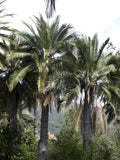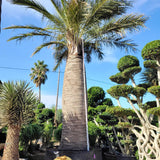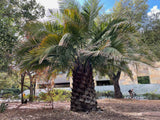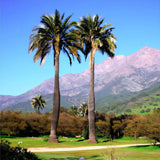“Chilean Wine Palm” (Jubaea chilensis) Seeds — A Living Monument in Every Seed
Step into the southern reaches of the Americas, where the wind carries tales of ancient palms, sugar‐sweet sap, and trees of such grandeur they seem to hold the horizon. These Jubaea chilensis seeds are more than just propagation material: they are whispers of resilience, symbols of cultural heritage, and the start of majestic palms that endure for centuries.
🌿 Botanical & Growth Highlights
-
Height & Trunk: When mature, Jubaea chilensis grows into a towering evergreen tree reaching 25-33 meters (≈ 80-110 feet), with a massive, columnar trunk up to 1.5-2 meters (≈ 5-6 ft) in diameter. It is considered one of the most massive palms in the world.
-
Leaves: The leaves are pinnate (feather-like), long, arching, with many rigid leaflets—gray-green above, somewhat silver-green below.
-
Flower / Bloom color: Sprays of purple and yellow flowers (male and female flowers on the same tree, since the species is monoecious) are produced in summer once the palm is mature (often many decades old).
-
Fruit / Seed: After flowering large clusters of rounded, edible yellow‐orange fruits appear. Each fruit contains a single seed (“coquito” in Spanish) with a nutty flavour after cracking the hard shell.
❄️ Hardiness
-
USDA Hardiness Zones: Jubaea chilensis is hardy in zones 7b through 10 (in some sources up to 11) depending on local conditions. It can survive brief dips down to about −12 °C to −15 °C (≈ 10–5 °F) if the root zone is protected and soil drains well.
-
Other tolerances: Very drought-tolerant once established; tolerates cold, winter wet in Mediterranean climates; needs full sun; does not like shade, salt spray, or extremely humid, tropical heat. Young palms are vulnerable to “bud rot” if excessively moist overhead.
🌍 Cultural Significance & History
-
Native home: Central Chile (regions of Coquimbo through Maule), where this is the only palm native to continental Chile. Endemic and deeply entwined with the Mediterranean climate ecosystem.
-
Sap & “Palm Honey”: The tree’s sap yields “miel de palma” (palm honey), a sweet sap concentrate, sometimes fermented, sometimes reduced to syrup. Historically, to extract this sap the tree was felled or its crown cut, a practice now regulated because it damages populations.
-
Seeds and fruit as food: The nuts (“coquitos”) are edible after cracking; the fruit pulp likewise, used in sweets or candied form. Edible oil can be extracted from the seed. These uses have made the palm both culturally and economically valuable.
-
Conservation: Once numbering in the millions, wild populations have declined drastically (over 90-95%) due to land conversion, sap and seed harvest, wildfires. Now classified as endangered in certain assessments; natural regeneration is limited.
🐝 Wildlife Interactions
-
Pollinators & nectar: The flowers of Jubaea chilensis are visited by insects, bees among them, seeking nectar and pollen. Although documentation is sparser than for some shrubs or herbs, bees are known to forage on its blooms.
-
Fruit as wildlife food: Birds and small mammals may feed on the fleshy fruits when ripe; in its native habitat, the fruit pulp provides food; seeds/dispersal by gravity and animals help regeneration.
-
Larval host for butterflies/moths: I found no reliable sources that list Jubaea chilensis as a larval host plant (i.e. caterpillars feeding on its foliage) in standard butterfly/moth databases. If you are particularly interested, local folk knowledge or entomological surveys might uncover species that use its fruit or foliage.
🌱 Growing from These Seeds
Planting these seeds is a journey in patience and wonder:
-
Germination may take from weeks to months (some sources say 4-6 weeks under ideal warm & moist conditions, others note up to a year for slower germination).
-
First many years of growth are slow. Trunk diameter builds gradually; height accumulates later. Sun, well-drained soil, occasional water until established, and protection from excessive moisture in the crown will help.
💫 Why These Seeds Are Special
Every seed carries legacy: a chance to grow one of the hardiest, slow-growing palms in the pinnate family. To plant a Jubaea chilensis is to plant a statement of endurance, a living symbol of Chilean natural history, and a reminder of the delicate balance of conservation and cultivation. Once mature, the palm’s silhouette—massive trunk, arching crowns—makes it a landmark tree, everywhere it stands.










